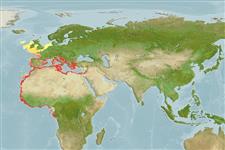Environment: milieu / climate zone / depth range / distribution range
Ökologie
seewasser demersal; tiefenbereich 20 - 500 m (Ref. 2683). Subtropical; 57°N - 5°S, 18°W - 36°E
Eastern Atlantic: Bay of Biscay (occasionally further north) and southwestern Mediterranean to the Strait of Gibraltar and the Gulf of Guinea, possibly even further south.
Length at first maturity / Size / Gewicht / Alter
Maturity: Lm 15.8 range ? - 21 cm
Max length : 45.0 cm TL Männchen/unbestimmt; (Ref. 3397); common length : 25.0 cm TL Männchen/unbestimmt; (Ref. 26999)
Rückenflossenstacheln (insgesamt): 12; Rückenflossenweichstrahlen (insgesamt): 10-11; Afterflossenstacheln 3; Afterflossenweichstrahlen: 8 - 9. Body tall, without stripes or bars. Small black spot at the pectoral fin base (Ref. 35388).
Inhabit various types of bottom but prefers gravel or rubble from 20 to about 500 m depth, abundance varying with depth according to the latitudes. Feed mainly on crustaceans and fish but also takes mollusks (Ref. 4781).
Bauchot, M.-L. and J.-C. Hureau, 1990. Sparidae. p. 790-812. In J.C. Quero, J.C. Hureau, C. Karrer, A. Post and L. Saldanha (eds.) Check-list of the fishes of the eastern tropical Atlantic (CLOFETA). JNICT, Lisbon; SEI, Paris; and UNESCO, Paris. Vol. 2. (Ref. 3688)
IUCN Rote Liste Status (Ref. 130435)
Bedrohung für Menschen
Harmless
Nutzung durch Menschen
Fischereien: kommerziell; Sportfisch: ja
Mehr Information
PartnerBilderStamps, Coins Misc.LauteCiguateraGeschwindigkeitSchwimmstilKiemenoberflächeOtolithsGehirngrößeSehfähigkeit
Tools
Zusatzinformationen
Download XML
Internet Quellen
Estimates based on models
Preferred temperature (Ref.
123201): 10 - 16.8, mean 13.5 °C (based on 312 cells).
Phylogenetic diversity index (Ref.
82804): PD
50 = 0.5001 [Uniqueness, from 0.5 = low to 2.0 = high].
Bayesian length-weight: a=0.01413 (0.01097 - 0.01819), b=3.03 (3.00 - 3.06), in cm total length, based on LWR estimates for this species (Ref.
93245).
Trophic level (Ref.
69278): 3.9 ±0.61 se; based on food items.
Widerstandsfähigkeit (Ref.
120179): mittel, Verdopplung der Population dauert 1,4 - 4,4 Jahre. (K=0.18-0.23).
Fishing Vulnerability (Ref.
59153): Moderate to high vulnerability (52 of 100).
Climate Vulnerability (Ref.
125649): Low vulnerability (11 of 100).
Nutrients (Ref.
124155): Calcium = 68.6 [38.2, 132.2] mg/100g; Iron = 1.04 [0.58, 1.83] mg/100g; Protein = 19.9 [18.5, 21.4] %; Omega3 = 0.515 [0.289, 0.917] g/100g; Selenium = 34.8 [16.9, 64.7] μg/100g; VitaminA = 13.6 [4.3, 38.6] μg/100g; Zinc = 0.672 [0.473, 0.965] mg/100g (wet weight); based on
nutrient studies.
